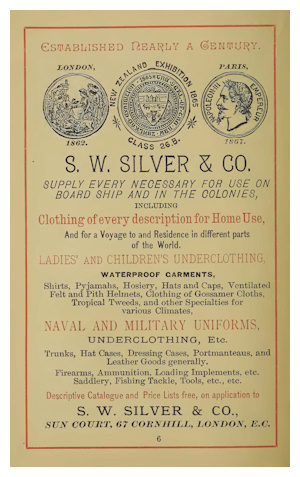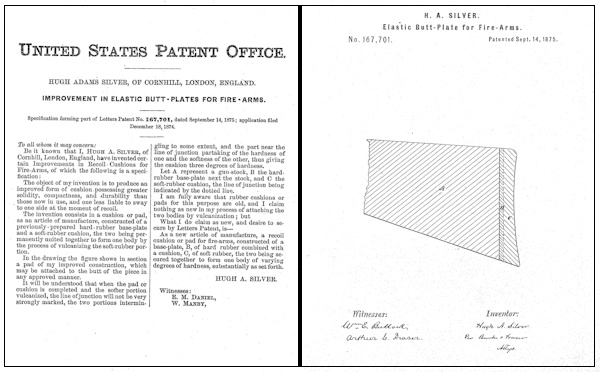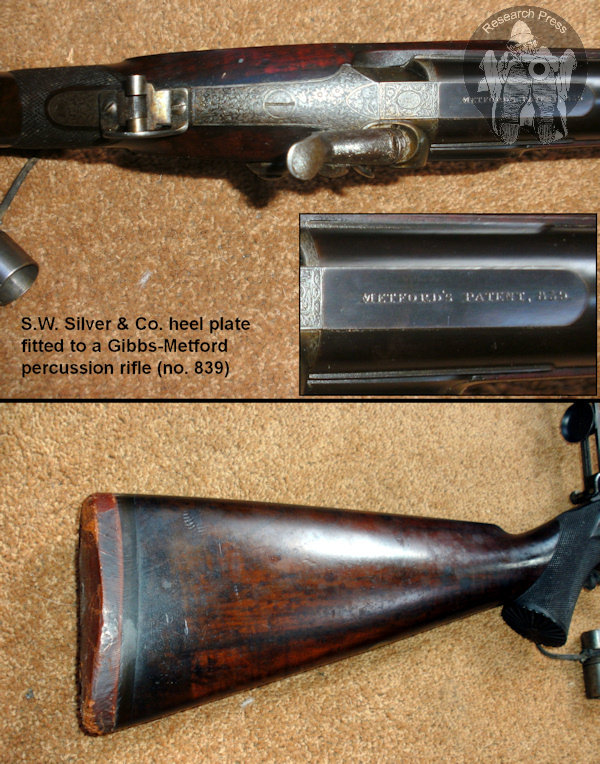You are here: Home > Firearms > Accessories
Written by: David Minshall

S.W. Silver & Co in their 1883 “Transatlantic Travellers Hand-book” were advertising themselves as being “established nearly a century”. Originally clothiers, outfitters and shipping agents, Stephen Winckworth Silver later established a rubber works at Greenwich making waterproof clothing. In 1855 S. W. Silver died and was succeeded by his two sons, Stephen William Silver and Hugh Adams Silver, who continued to expand the business, including insulated wires and cables.
In 1874 H.A. Silver was granted a firearms related patent for an India-rubber cushion applied to the butt end of a stock. Notification which appeared in ‘The Engineer’ (18 March 1875) states:
2938. Stocks, Butts, Heel-Plates, and Locks of Fire-Arms, H.A. Silver, Sun-court, Cornhill – Dated 27th August, 1874. This consists in the adaptation of a suitable elastic material or spring to the butt end of the stock, by means of which the shock of the recoil when the weapon is fired off is much diminished and effects greatly neutralised.
A patent was also granted in the United States to H.A. Silver for “Improvement in Elastic Butt-Plates for Fire-Arms” (Letters Patent No. 167,701, dated 14 September 1875).

The merits of the butt-plate were noted in the Edinburgh Evening News (Friday, 9 October 1874) which published the following notice.
A NEW RIFLE PAD
At the last Wimbledon meeting the Rifle Association, says the London correspondent of the Leeds Mercury, in July the complaints against the kicking properties of the Government Martini-Henry rifle were loud and strong. The justice of the complaint, which came as much from the Regulars as from the Volunteers, convinced the authorities of the need of some change in the present system. I have just seen an invention by Messrs Silver and Co., which is about to be submitted to the War Office authorities. It consists of a heel plate in soft vulcanised indiarubber, which absorbs the heaviest recoil and guards against the danger from which the shooter now suffers of having his shoulder rendered so stiff or sore after firing a number of shots. The indiarubber pad, for it is practically that, will resist any heat, and may be attached by the regimental armourer to the existing weapon at a trifling cost. It will be a real blunder if after having obtained the best breechloader in the world for our troops, we render it useless or, at least, diminish its value by neglecting a precaution which will render it perfect.
Since 1871 the Martini-Henry rifle had been issued for the second stage of the Queen’s Prize Competition, fired at Wimbledon in the Annual Rifle Meeting of the National Rifle Association (NRA). In 1874 Earl Ducie in addressing competitors regarding the regulations included that a handkerchief might be wrapped round the butt of the rifle to prevent injury to the face from the recoil. Press reports about the recoil, trigger and erratic shooting of the Martini-Henry at Wimbledon caused concern. In the House of Commons on Thursday 30 July 1874 Mr. Anderson (Glasgow) asked the Secretary of State for War if he had heard reports condemnatory of the Martini-Henry rifles used at Wimbledon, and if it were the fact that the (NRA) Council issued an order permitting competitors to wind handkerchiefs round the stocks to mitigate the contusions on the cheek of the marksmen caused by the kick of the rifle. Lord Eustace Cecil (Surveyor-General) in replying to the latter point said the National Rifle Association had, he believed, permitted competitors to use handkerchiefs round the stocks of small-bore rifles, but that had not been confined to the Martini-Henry rifle, and the rule had been in force for some years.
In March 1875 the Pall Mall Gazette published comment on the Martini-Henry and referred to its “excessive recoil”. Reportedly the “War Office authorities have within the past few weeks adopted this expedient, the bullet being now 410 grains instead of 480 grains, and the charge 80 grains instead of 85, the recoil being thus reduced it is said, about 20 per cent.”
Correspondence from Mr. R. H. W. Dunlop, Captain of the Scottish Eight, in response to this report was published in the Pall Mall Gazette (Saturday, 27 March 1875). Dunlop criticised the method used for “reducing the kick, by reducing the powder charge and weight of bullet”, continuing that it was “an unnecessary reduction of the power of the weapon. It is a concealment, not a removal, of a defect. No competent critics complained of the ‘abstract recoil ‘ of the old pattern Martini-Henry, but of the kick only, i.e. the direction or distribution of the recoil due chiefly to defective shape and deficient length of stock.”
Dunlop also made the following observation; “The recoil of the match Metford is seven pounds more than that of the Martini-Henry as it stood last autumn, but while the kick of the ‘miserable malformation’ [a then current derogatory reference to the Martini-Henry] was intolerable, that of the match Metford was comparatively nil.”
Silver’s heel-plate was not adopted for military use but it was used on sporting guns and rifles. The 1870s were a transitional period with regards to firearms development. While the military had adopted breech-loading rifles (commencing with the Snider-Enfield in 1866), on the ranges the muzzle-loading match rifle remained popular with marksmen. Indeed it wasn’t until 1881 that the Elcho Shield competition was fired entirely with breech loaders.
Although contemporary with the British percussion match rifle, Silver’s heel-plate is only occasionally seen on them. Dunlop’s observations above regarding the proper design of stock and lack of felt recoil with the match rifle may be one reason for this.
Major S.S. Young writing on muzzle loading match rifle shooting in the Volunteer Service Gazette in 1877 (and later included within his book ‘The Three Rifles‘), noted: “Should the recoil seem excessive, one of Silver’s anti-recoil heel-plates or an ordinary india-rubber shoe-pad, will effectually protect the shoulder without in any way affeting the accuracy of the shot.”
Pictured below is a Silver’s butt-plate fitted to a Gibbs-Metford muzzle loading match rifle. The barrel is numbered ‘Metford’s Patent, 839’. Interestingly, this rifle in a private collection can be attributed to Sir Henry Halford. In a letter published in ‘The Spirit of the Times’’ (USA), 23 March 1878, Halford writes about rifle experiments he has undertaken and in listing rifles used in the experiments he refers to:
“A Metford muzzle-loader, No. 839 (the rifle I shot with in the Centennial Match)”
The reference to the Centennial Match is the long range rifle team competition that was held at Creedmoor, USA, in 1877 between Great Britain and the United States. Halford was the British Team Captain.
